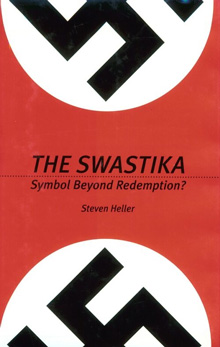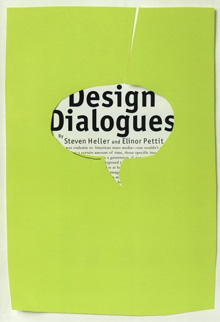
Steve Heller
October 31, 2002
by Armin Vit
Speak Up: For a writer who has tackled every conceivable topic in the field of Graphic Design, from the myths of the Swastika to Cuba's visual history, how do you approach new projects?
Steve Heller: Whatever strikes
my fancy seems ripe for something -- article, book, dance, e-mail conversation.
I try to find the story in whatever I'm interested in. Telling stories is very
important.
SU: Are you afraid, although
that might not be the right word, that you will eventually have no theme to
discuss? Or in a less promising scenario that designers will say 'oh! another
Steve Heller book', roll their eyes and instead favor the latest (and trendiest)
designer biography/portfolio book?
SH: Yep. While there is an endless supply of new experiences, I'm always
scaring myself that I'll run out of curiosity. And Yep, I hear that
very "another Heller book" line from people. I realize over
saturation has its downside, but I'm addicted to exploring. Perhaps
some of my books are written before the information is fully
digested, and that is a problem.

|
I'm always scaring myself that I'll run out of curiosity. |
|
 |
|

SU: This might be old news.
What did you think of the "patriotism" shown by designers after the September
11 attacks? Every organization from the
AIGA
to Italy's
Fabrica
was encouraging designers to submit artwork, but was it just a little bit too
much?
SH: It is old news and frankly
no longer of interest to me. Patriotism has its good and bad sides. From a design
point of view we can be patriotic and make objects that do good for people,
or we can be nationalistic and produce clichés that further fill the
world with mediocrity. But despite my criticism of the post 9/11 graphic output
I do feel it was heartfelt. People were grappling with issues, concerns, and
fears, which manifest in images that relied on timeworn idioms -- and that is
inevitable.
SU: Granted, some of the images
and graphics created were extremely powerful and emotional. I can't help but
think that with Graphic Design being so image oriented and preoccupied with
recognition this was nothing more than another opportunity to get their work
exposed, and use these events as a vehicle for self-promotion. Maybe even one
more attempt to convince the public that design matters?
SH: Perhaps there is an element of opportunism, but I don't think that
was the majority feeling. I think people just wanted to say something
-- anything.
SU: Do you feel like, and this
question might apply to every trade, Graphic Design lacks dialogue between it's
practicing professionals? Yes, we have publications, conferences and lectures,
but it all seems to be a one way street with designers concerned only about
talking and not listening. After all we are in the business of communication.
This just sparked the opposite thought, do we really need dialogue at all in
our field?
SH: Depends on the dialogue. We're a large "community." Some people talk,
others listen, still others talk and listen, and still more just let
the world go by. I think we have enough outlets for discussion
between the trade press, organizations like AIGA, and now the bloody
web. More important, we should integrate more with other cultural
activities.

|
 |
|
Some people talk,
others listen, still others talk and listen, and still more just let the world go by.
|
|

SU: We have all heard how much
design "styles" can vary in the various regions of the US. Print Magazine ran
an article (I just can't find the issue that was printed on) about this same
topic, with a rather pointless quiz about matching styles with their regions.
LA natives can't stand New Yorkers and vice-versa. In a talk by Stefan Sagmeister
in Atlanta, GA he was asked what inspired him, and his first response without
hesitation was 'New York'. What, in your opinion, separates New York from the
rest of the US and has established it as one of the greatest Graphic Design
centers in the world?
SH: New York is simply a vibrant
place, full of energy (both positive and negative). Stefan comes from tidy Europe
but his mind is best suited for HERE. I don't think of him as Austrian, I see
him is devoutly New Yorkian. But more specifically, New York is a melting pot
to use a cliché, and there are so many influences and inspirations that
its hard not to be energized - or for that matter competitive, which means a
high degree of trying to out do the next guy.
SU: What is your take on the AIGA and other organizations devoted to
Graphic Design? Are they doing enough for our profession? They talk about educating the public, setting ethic standards and promoting
Design as a valuable business tool, but in pure appearance they just
seem to be concerned about booking that month's "hot" designer for
their next conference. At the moment I am not actively involved with
any organization but I follow their events, articles and general
doings in the "Front End", what is happening in the "Back End"?
SH: Any organization is what you bring to it. When I first got involved
with the AIGA many years ago it was as the "curator" of a show on
Political Art. The then director gave me her full support and I used
that as an opportunity to open the discussion of what is effective
polemics. I got Tom Wolfe, Tom Wicker, and others involved in the
selection process. What I'm saying is that one has to be involved
rather than watch from the sidelines. If there are too many "hot"
designers on the stage, bring something else to the stage. But I
would disagree with you in any case, I think AIGA does a great job of
promoting many areas of cultural concern beyond the parochial aspects
of the profession. I don't go to the pure trade events, but I love
the ones that go beyond -- and in New York, for example, there are
many.
best
steve h

This interview has been conducted exclusively for Speak Up.
Reproduction without our written consent is strictly prohibited. Please if you would like to use it for educational purposes or if you are interested in other means of reproduction. Thank you for your understanding.



